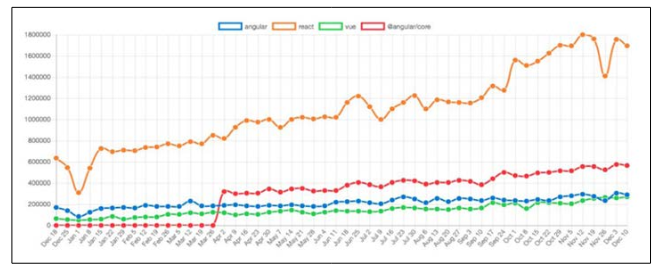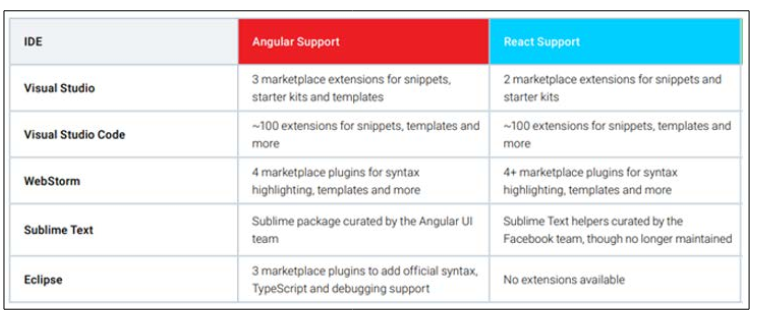Author(s): <p>Abhishek Shukla</p>
The main aim of the paper is to provide some innovative solutions to manage projects by using JavaScript Frameworks. As the world is moving towards high technology in web development. Therefore, the selection of the right JavaScript framework for a project is an extremely challenging task. Due to this, the article will explore some innovative solutions for managing projects that employ various JavaScript frameworks like Angular and Reach within the same project. Furthermore, it will also examine the drawbacks and benefits of each framework in detail by delving into the challenges of integrating them. Also, it will propose some strategies for effective project management. By comparing these two popular frameworks, it will become simple to provide comprehensive insights into optimizing development workflows, achieving better project outcomes, and enhancing collaboration.
Due to the increase in technology in web development, JavaScript has evolved significantly over the years with its important frameworks and libraries emerging for streamlining web development. From this, two of the most important and prominent frameworks include React and Angular. These two frameworks have gained widespread adoption in the field of the web development community. However, for large-scale projects, it is not common to require the use of multiple frameworks to meet specific requirements [1]. Therefore, it will create a huge challenge for developers and project managers in terms of maintenance, integration, and collaboration. This article will explore in detail some innovative solutions that can be used to manage projects effectively through various JavaScript frameworks within the same codebase [2].
In this section, there is proper information regarding the information and research of important researchers based on the topic [3].
One of the most important challenges related to combining various JavaScript frameworks within a single project is related to the potential for dependency conflicts. Due to this, each framework may contain some specific dependencies and require specific versions of libraries. Therefore, when these dependencies clash with each other, it can lead to various issues like unexpected behavior, runtime errors, or even project instability [4].
However, resolving conflicts is not easy and it will lead to various problems like time consumption. Therefore, the developers need to manage package versions, and package managers like yarn, and npm effectively and employ various techniques like package deduplications that can ensure compatibility [4].
Using various multiple JavaScript frameworks necessitates that the developers can gain proficiency in each of them. Due to this, it will pose a significant learning curve. This curve is posed especially for team members who are not familiar with one framework or another. If the developers learn various JavaScript Frameworks, then it will lead to a fragmented skill set within the development team and impact potentially the code quality and productivity [5].
The integration of various JavaScript Frameworks can result in a highly complex database. This complexity level is increased by the need to manage framework-specific code, component interactions, routing, and state management. When the codebase grows, then it will become extremely challenging to maintain and debug. It is also potentially leading to longer development cycles with increased maintenance costs [6]. To address codebase complexity, the developers can employ architectural patterns that promote code separation and modularity [3].
While working with various frameworks, performance is considered an important factor. The reason behind this is that Mixing Frameworks indiscriminately can lead to various inefficiencies. These inefficiencies include redundant rendering, slow page load times, and excessive memory consumption. Such performance issues will have some negative impacts on user experience and should be carefully monitored and optimized [2]. Secondly, some performance profiling tools like browser tools, and third-party libraries like Lighthouse can help the system to identify bottlenecks and areas for improvement. It shows that the developers must consider code splitting and lazy coding techniques to reduce the initial load time of the application [2].
It is considered an important architectural pattern that extends the principles of micro service to the frontend layer of web applications. According to this approach, the front end of an application is divided into deployable, independent, smaller, and scalable units called micro frontends. Secondly, each micro frontend contains its own JavaScript Framework, technology stack, and library to allow development teams to choose the tools that are reliable for specific modules or features [2].
There are also some advantages of Micro Frontends to project management are given below:
Some various teams or developers can easily work on separate micro frontends without interfering with the other one. Due to this, it will promote team autonomy and parallel development [5].
It is possible to scale independently to meet changing demand, and enhance the ability of the application to handle increased traffic [5].
For some specific use cases, the team can select the most appropriate JavaScript Framework or library that will result in a tailored solution [6].
These frontends can be deployed independently enabling continuous integration and deployment practices on the system [2].
The Micro Frontend developers are using various JavaScript Frameworks that include Angular, React, Angular Core, and Vue. All these frameworks contain their advantages or disadvantages. The graph given below shows the total number of downloads of these frameworks from the last year [4].

Figure 1: Total Number of Downloads in the Past Year of JavaScript Frameworks
It shows that the wrapper components are also called bridge components or integration components. These components can be used as intermediary elements that can be used in a project. Moreover, it can also encapsulate the logic and functionality of specific JavaScript frameworks or libraries. Also, these components serve as a main bridge between various frameworks and provide a standardized interface for interaction and communication [2]. The key attributes of Wrapper components are given below
It is simple for wrapper components to isolate the frameworkspecific code within a well-defined boundary that will minimize the likelihood of conflicts or compatibility issues [3].
The wrapper components can easily abstract the complexity of a particular framework that will allow other parts of the application to interact with a consistent and simplified interface [6].
With wrapper components, it will become simple to update or replace a specific framework since changes are confined to the component itself and not affecting the entire codebase [2].
They also enable various parts of the application that are built from various frameworks to seamlessly share and collaborate data.
It involves creating a unified layer for making data requests and handling backend communication effectively. On the other hand, instead of allowing various parts of the application or frameworks to interact with backend services, they can easily communicate by using a common API abstraction layer [3]. There are some key aspects of API Abstraction are given below:
With API abstraction, a consistent approach is enforced to data retrieval and manipulation across the application. It will also minimize the likelihood of inconsistencies or errors.
It allows the Frontend developers to make various changes to the frontend without worrying about the backend implementation [6].
Under these facts, the table given below shows some information about the IDE used by the frontend developers for implementing two JavaScript Frameworks Angular Support and React Support [3].

Figure 2: The Information about Various IDE for Angular and React JavaScript Frameworks
Summing up all the discussion from above, it is concluded that a dynamic web development landscape is created due to advanced technologies. Therefore, the need to combine various JavaScript Frameworks in a single domain is extremely important. However, such approaches present some challenges, and innovative solutions like Micro Frontends, API Abstractions, and Wrapper Components can help the system mitigate the complexities and streamline project management. After considering the requirements carefully about the projects and providing some strengths of each framework. Also, the development teams can harness the power of Reach, Angular, and other JavaScript frameworks for creating efficient and robust web applications. Through embracing these technologies will lead to improved collaboration, provide between project outcomes, and minimize development time. Secondly, as the technology continues to evolve, staying open to new approaches and updated with new approaches will be extremely important for successfully managing projects that leverage multiple JavaScript Frameworks.
